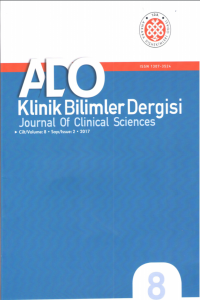Geçmişten Günümüze Ortodontide Ankraj
diş hareketi, optimal kuvvet, ortodontide ankraj
___
- Baker RW, Guay AH, Peterson HW Jr. Current concepts of anchorage management. Angle Orthod. 1972;42(2):129-138.
- Proffıtt WR. Ed: Darendeliler N. Güncel Ortodonti. 6.Baskı. Ankara Nobel Tıp Kitapevleri. Ankara; 2020. s.249-309.
- Sam W. Minimal forces in tooth movement. Am J Orthod. 1967;53(12):881-903.
- Williams JK, Isaacson KG, Cook PA, Thom AR. Fixed orthodontic appliances principles and practice. 1st edition. Butterworth-Heinemann. Oxford; 1995. p.8-15.
- Iannetti G, Martucci E, Silvestri A, Cascone P. Analisi cefalometrica secondo Steiner e studio del trattamento (Steiner's cephalometric analysis and treatment study). Minerva stomatol. 1981;30(3):151-168.
- Ülgen M. Anomaliler, sefalometri, etiyoloji, büyüme ve gelişim, tanı. 5. Baskı. Dicle Üniversitesi Diş Hekimliği Fakültesi Yayınları. Diyarbakır; 2015. s.43-110.
- Santana LG, de Campos França E, Flores-Mir C, Abreu LG, Marques LS, Martins-Junior PA. Effects of lip bumper therapy on the mandibular arch dimensions of children and adolescents: A systematic review. Am J Orthod Dentofacial Orthop. 2020;157(4),454-465.
- Bartzela T, Turp JC, Motschall E, Maltha JC. Medication effects on the rate of orthodontic tooth movement: A systematic literature review. Am J Orthod. 2009;135(1):16-26.
- Ülgen M. Ortodontik tedavi prensipleri. 8. Baskı. Dicle Üniversitesi Diş Hekimliği Fakültesi Yayınları. Diyarbakır; 2015. s.251- 267.
- Singh G. Textbook of orthodontics. 1st edition. Jaypee Brothers Medical Publishers (P) Ltd. New Delhi; 2004. p.233-241.
- Nahidh M, Al Azzawi AM, Al-Badri SC. Understanding anchorage in orthodontics-review article. J Dent & Oral Disord. 2019;5(2):2.
- Horner KA, Behrents RG, Kim KB, Buschang PH. Cortical bone and ridge thickness of hyperdivergent and hypodivergent adults. Am J Orthod. 2012;142(2):170-8.
- Moller E. The chewing apparatus: An electromyographic study of the action of the muscles of mastication and its correlation to facial morphology. Acta Physiol Scand. (Suppl). 1966;280(1):229.
- Ding WH, Li W, Chen F, Zhang JF, Lv Y, Chen XY, et al. Comparison of molar intrusion efficiency and bone density by CT in patients with different vertical facial morphology. J Oral Rehabil. 2015;42(5):355-62.
- Schwarz A. Tissue changes incident to orthodontic tooth movement. Int J Orthod. 1932; 18(4):331-352.
- Oppenheim A. Human tissue response to orthodontic intervention of short and long duration. Am J Orthod. 1942;28(5):263-301.
- Yee JA, Türk T, Elekdağ-Türk S, Cheng LL, Darendeliler MA. Rate of tooth movement under heavy and light continuous orthodontic forces. Am J Orthod. 2009;136(2):150-1.
- Theodorou CI, Kuijpers-Jagtman AM, Bronkhorst EM, Wagener FADTG. Optimal force magnitude for bodily orthodontic tooth movement with fixed appliances: A systematic review. Am J Orthod. 2019;156(5):582-92.
- Pilon JGM, Kuijpers-Jagtman AM, Maltha JC, Magnitude of orthodontic forces and rate of bodily tooth movement. An experimental study. Am J Orthod. 1996;110(1):16-23.
- Jaraback JR, Fizzel JA. Technique and treatment with the light-wire appliances. 1st edition. Mosby, St. Louis; 1963. p.17-29.
- Philippe J. The birth of Edgewise or the last and best Angle's mechanisms. Orthod Fr 2016;87(3):347-351.
- Begg PR. Begg Orthodontic Theory and Technique. 3rd edition. W.B. Saunders Company. Philadelphia; 1977. p.68-92.
- Andrews LF. The straight-wire appliance. Br J Orthod. 1979;6(3):125-143.
- Ricketts RM. Bioprogressive therapy as an answer to orthodontic needs. Part I. Am J Orthod. 1976;70(3):241-268.
- Urias D, Mustafa FIA. Anchorage Control in Bioprogressive vs Straight-wire Treatment. Angle Orthod. 2005;75(6):987-92.
- Gottsegen MI. Self-ligating brackets: Looking back and going forward. Am J Orthod. 2010;138(5):532.
- McLaughlin RP, Bennett JC, Trevisi HJ. Systemized orthodontic treatment mechanics. 1st edition. Elsevier Health Sciences. Netherlands; 2001. p.90-166.
- Cope JB. Temporary anchorage devices in orthodontics: A paradigm shift. Semin Orthod. 2005;11(1):3-9.
- Nadire T, Kocadereli Tİ. Ankraj sistemlerine genel bakış: Ortodontide mikroimplant ankraj sistemleri. Cumhuriyet Üniversitesi Diş Hekimliği Fakültesi Dergisi. 2006;9(1):68-75.
- Creekmore TD, Eklund MK. The possibility of skeletal anchorage. J Clin Orthod. 1983;17(4):266-269. McGuire MK, Scheyer ET, Gallerano RL. Temporary anchorage devices for tooth movement: a review and case reports. J Periodontol. 2006;77(10):1613-24.
- Cheng SJ, Tseng IY, Lee JJ, Kok SH. A prospective study of the risk factors associated with failure of mini- implants used for orthodontic anchorage. Int J Oral Maxillofac Implants. 2004;19(1):100-6.
- De Clerck H, Geerinckx V, Siciliano S. The zygoma anchorage system. J Clin Orthod. 2002;36(8):455-459.
- ISSN: 1307-3540
- Yayın Aralığı: Yılda 3 Sayı
- Başlangıç: 2006
- Yayıncı: Ankara Diş Hekimleri Odası
Mandibula Ramus Bölgesinde Lokalize Kompleks Odontoma: Cerrahi Sonrası 1 Yıllık Takip
Sara SAMUR ERGÜVEN, Yeliz KILINÇ, Ertan DELİLBAŞI, İpek ATAK SEÇEN
Bütüncül Tıp Bakış Açısıyla Uyku Bruksizmi
Diş Hekimliğinde Oromaksillofasiyal Bölgeden Alınabilen Mezenkimal Kök Hücreler
Sefer MAHMUTOĞLU, Ayşegül MENDİ, Derviş YILMAZ
Mandibuler Anestezi için Vazirani-Akinosi Kapalı Ağız Tekniği
Cevahir CENGİZ, Gülşah KARATAŞ, Sara SAMUR ERGÜVEN
İki Farklı CAD/CAM Materyalinin Farklı Kalınlıklarda Translusensi Özelliğinin Değerlendirilmesi
Mohamed Amar HWİDİ, Mine Betül ÜÇTAŞLI
Yeni Tip Koronavirüs (COVID-19) Salgınının Diş Hekimlerinin Tedavi Kliniği Düzeni Üzerine Etkisi
Onur Altuğ SAKALLI, Sedanur SAKALLI, Aleyna Öykü AKBAŞAK, Selim ERKUT
Silikon Replika Dayanak ile Ekstraoral Simantasyon Tekniği: Olgu Sunumu
Ekstraoral Parlatma İşlemlerinin Translüsent Monolitik Zirkonyanın Yüzey Pürüzlülüğüne Etkisi
Sevinç ERTUĞRUL, Seda YILDIRIM, Bulem YÜZÜGÜLLÜ
Covid-19 Sürecinde Diş Hekimliği Eğitimi: Etkisi, Gelişen Teknolojiler ve Eğilimler
